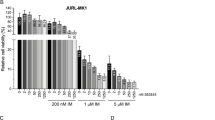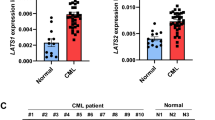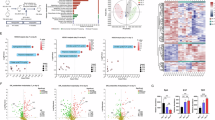Abstract
We examined the involvement of sphingosine kinase-1 (SphK1), which governs the ceramide/sphingosine-1-phosphate balance, in susceptibility to imatinib of either sensitive or resistant chronic myeloid leukemia cells. Imatinib-sensitive LAMA84-s displayed marked SphK1 inhibition coupled with increased content of ceramide and decreased pro-survival sphingosine-1-phosphate. Conversely, no changes in the sphingolipid metabolism were observed in LAMA84-r treated with imatinib. Overcoming imatinib resistance in LAMA84-r with farnesyltransferase or MEK/ERK inhibitors as well as with cytosine arabinoside led to SphK1 inhibition. Overexpression of SphK1 in LAMA84-s cells impaired apoptosis and inhibited the effects of imatinib on caspase-3 activation, cytochrome c and Smac release from mitochondria through modulation of Bim, Bcl-xL and Mcl-1 expression. Pharmacological inhibition of SphK1 with F-12509a or its silencing by siRNA induced apoptosis of both imatinib-sensitive and -resistant cells, suggesting that SphK1 inhibition was critical for apoptosis signaling. We also show that imatinib-sensitive and -resistant primary cells from chronic myeloid leukemia patients can be successfully killed in vitro by the F-12509a inhibitor. These results uncover the involvement of SphK1 in regulating imatinib-induced apoptosis and establish that SphK1 is a downstream effector of the Bcr-Abl/Ras/ERK pathway inhibited by imatinib but upstream regulator of Bcl-2 family members.
This is a preview of subscription content, access via your institution
Access options
Subscribe to this journal
Receive 12 print issues and online access
$259.00 per year
only $21.58 per issue
Buy this article
- Purchase on SpringerLink
- Instant access to full article PDF
Prices may be subject to local taxes which are calculated during checkout






Similar content being viewed by others
References
Melo JV, Barnes DJ . Chronic myeloid leukaemia as a model of disease evolution in human cancer. Nat Rev Cancer 2007; 7: 441–453.
Barnes DJ, Palaiologou D, Panousopoulou E, Schultheis B, Yong AS, Wong A et al. Bcr-Abl expression levels determine the rate of development of resistance to imatinib mesylate in chronic myeloid leukemia. Cancer Res 2005; 65: 8912–8919.
Mahon FX, Deininger MW, Schultheis B, Chabrol J, Reiffers J, Goldman JM et al. Selection and characterization of BCR-ABL positive cell lines with differential sensitivity to the tyrosine kinase inhibitor STI571: diverse mechanisms of resistance. Blood 2000; 96: 1070–1079.
le Coutre P, Tassi E, Varella-Garcia M, Barni R, Mologni L, Cabrita G et al. Induction of resistance to the Abelson inhibitor STI571 in human leukemic cells through gene amplification. Blood 2000; 95: 1758–1766.
Barnes DJ, Schultheis B, Adedeji S, Melo JV . Dose-dependent effects of Bcr-Abl in cell line models of different stages of chronic myeloid leukemia. Oncogene 2005; 24: 6432–6440.
Mandanas RA, Leibowitz DS, Gharehbaghi K, Tauchi T, Burgess GS, Miyazawa K et al. Role of p21 RAS in p210 bcr-abl transformation of murine myeloid cells. Blood 1993; 82: 1838–1847.
Cortez D, Stoica G, Pierce JH, Pendergast AM . The Bcr-Abl tyrosine kinase inhibits apoptosis by activating a Ras-dependent signaling pathway. Oncogene 1996; 13: 2589–2594.
Hoover RR, Mahon FX, Melo JV, Daley GQ . Overcoming STI571 resistance with the farnesyl transferase inhibitor SCH66336. Blood 2002; 100: 1068–1071.
Peters DG, Hoover RR, Gerlach MJ, Koh EY, Zhang H, Choe K et al. Activity of the farnesyl protein transferase inhibitor SCH66336 against BCR/ABL-induced murine leukemia and primary cells from patients with chronic myeloid leukemia. Blood 2001; 97: 1404–1412.
Matulonis U, Salgia R, Okuda K, Druker B, Griffin JD . Interleukin-3 and p210 BCR/ABL activate both unique and overlapping pathways of signal transduction in a factor-dependent myeloid cell line. Exp Hematol 1993; 21: 1460–1466.
Kang C, Yoo S, Hwang B, Kim K, Kim D, Kim C et al. The inhibition of ERK/MAPK not the activation of JNK/SAPK is primarily required to induce apoptosis in chronic myelogenous leukemic K562 cells. Leuk Res 2000; 24: 527–534.
Yu C, Krystal G, Varticovksi L, McKinstry R, Rahmani M, Dent P et al. Pharmacologic mitogen-activated protein/extracellular signal-regulated kinase kinase/mitogen-activated protein kinase inhibitors interact synergistically with STI571 to induce apoptosis in Bcr/Abl-expressing human leukemia cells. Cancer Res 2002; 62: 188–199.
Dan S, Naito M, Tsuruo T . Selective induction of apoptosis in Philadelphia chromosome-positive chronic myelogenous leukemia cells by an inhibitor of Bcr-Abl tyrosine kinase, CGP 57148. Cell Death Differ 1998; 5: 710–715.
Kawauchi K, Ogasawara T, Yasuyama M, Ohkawa S . Involvement of Akt kinase in the action of STI571 on chronic myelogenous leukemia cells. Blood Cells Mol Dis 2003; 31: 11–17.
Kohmura K, Miyakawa Y, Kawai Y, Ikeda Y, Kizaki M . Different roles of p38 MAPK and ERK in STI571-induced multi-lineage differentiation of K562 cells. J Cell Physiol 2004; 198: 370–376.
Tipping AJ, Mahon FX, Zafirides G, Lagarde V, Goldman JM, Melo JV . Drug responses of imatinib mesylate-resistant cells: synergism of imatinib with other chemotherapeutic drugs. Leukemia 2002; 16: 2349–2357.
Cuvillier O, Pirianov G, Kleuser B, Vanek PG, Coso OA, Gutkind S et al. Suppression of ceramide-mediated programmed cell death by sphingosine-1-phosphate. Nature 1996; 381: 800–803.
Olivera A, Kohama T, Edsall L, Nava V, Cuvillier O, Poulton S et al. Sphingosine kinase expression increases intracellular sphingosine-1-phosphate and promotes cell growth and survival. J Cell Biol 1999; 147: 545–558.
Edsall LC, Cuvillier O, Twitty S, Spiegel S, Milstien S . Sphingosine kinase expression regulates apoptosis and caspase activation in PC12 cells. J Neurochem 2001; 76: 1573–1584.
Pchejetski D, Golzio M, Bonhoure E, Calvet C, Doumerc N, Garcia V et al. Sphingosine kinase-1 as a chemotherapy sensor in prostate adenocarcinoma cell and mouse models. Cancer Res 2005; 65: 11667–11675.
Bonhoure E, Pchejetski D, Aouali N, Morjani H, Levade T, Kohama T et al. Overcoming MDR-associated chemoresistance in HL-60 acute myeloid leukemia cells by targeting sphingosine kinase-1. Leukemia 2006; 20: 95–102.
Taha TA, Osta W, Kozhaya L, Bielawski J, Johnson KR, Gillanders WE et al. Down-regulation of sphingosine kinase-1 by DNA damage: dependence on proteases and p53. J Biol Chem 2004; 279: 20546–20554.
Nava VE, Cuvillier O, Edsall LC, Kimura K, Milstien S, Gelmann EP et al. Sphingosine enhances apoptosis of radiation-resistant prostate cancer cells. Cancer Res 2000; 60: 4468–4474.
Cuvillier O, Levade T . Sphingosine 1-phosphate antagonizes apoptosis of human leukemia cells by inhibiting release of cytochrome c and Smac/DIABLO from mitochondria. Blood 2001; 98: 2828–2836.
Horita M, Andreu EJ, Benito A, Arbona C, Sanz C, Benet I et al. Blockade of the Bcr-Abl kinase activity induces apoptosis of chronic myelogenous leukemia cells by suppressing signal transducer and activator of transcription 5-dependent expression of Bcl-xL. J Exp Med 2000; 191: 977–984.
Aichberger KJ, Mayerhofer M, Krauth MT, Skvara H, Florian S, Sonneck K et al. Identification of mcl-1 as a BCR/ABL-dependent target in chronic myeloid leukemia: evidence for cooperative antileukemic effects of imatinib and mcl-1 antisense oligonucleotides. Blood 2005; 105: 3303–3311.
Kuroda J, Puthalakath H, Cragg MS, Kelly PN, Bouillet P, Huang DC et al. Bim and Bad mediate imatinib-induced killing of Bcr/Abl+ leukemic cells, and resistance due to their loss is overcome by a BH3 mimetic. Proc Natl Acad Sci USA 2006; 103: 14907–14912.
Greene LM, Kelly L, Onnis V, Campiani G, Lawler M, Williams DC et al. STI-571 (imatinib mesylate) enhances the apoptotic efficacy of pyrrolo-1,5-benzoxazepine-6, a novel microtubule-targeting agent, in both STI-571-sensitive and -resistant Bcr-Abl-positive human chronic myeloid leukemia cells. J Pharmacol Exp Ther 2007; 321: 288–297.
Marley SB, Lewis JL, Schneider H, Rudd CE, Gordon MY . Phosphatidylinositol-3 kinase inhibitors reproduce the selective antiproliferative effects of imatinib on chronic myeloid leukaemia progenitor cells. Br J Haematol 2004; 125: 500–511.
Kaufmann SH . Imatinib spells BAD news for Bcr/abl-positive leukemias. Proc Natl Acad Sci USA 2006; 103: 14651–14652.
Skorski T, Kanakaraj P, Ku DH, Nieborowska-Skorska M, Canaani E, Zon G et al. Negative regulation of p120GAP GTPase promoting activity by p210bcr/abl: implication for RAS-dependent Philadelphia chromosome positive cell growth. J Exp Med 1994; 179: 1855–1865.
Nakajima A, Tauchi T, Sumi M, Bishop WR, Ohyashiki K . Efficacy of SCH66336, a farnesyl transferase inhibitor, in conjunction with imatinib against BCR-ABL-positive cells. Mol Cancer Ther 2003; 2: 219–224.
Pitson SM, Moretti PA, Zebol JR, Lynn HE, Xia P, Vadas MA et al. Activation of sphingosine kinase 1 by ERK1/2-mediated phosphorylation. EMBO J 2003; 22: 5491–5500.
Xia P, Gamble JR, Wang L, Pitson SM, Moretti PA, Wattenberg BW et al. An oncogenic role of sphingosine kinase. Curr Biol 2000; 10: 1527–1530.
Reiter A, Hochhaus A, Berger U, Kuhn C, Hehlmann R . AraC-based pharmacotherapy of chronic myeloid leukaemia. Expert Opin Pharmacother 2001; 2: 1129–1135.
Cuvillier O, Edsall L, Spiegel S . Involvement of sphingosine in mitochondria-dependent Fas-induced apoptosis of type II Jurkat T cells. J Biol Chem 2000; 275: 15691–15700.
Tepper AD, de Vries E, van Blitterswijk WJ, Borst J . Ordering of ceramide formation, caspase activation, and mitochondrial changes during CD95- and DNA damage-induced apoptosis. J Clin Invest 1999; 103: 971–978.
Kantarjian H, Giles F, Wunderle L, Bhalla K, O'Brien S, Wassmann B et al. Nilotinib in imatinib-resistant CML and Philadelphia chromosome-positive ALL. N Engl J Med 2006; 354: 2542–2551.
Talpaz M, Shah NP, Kantarjian H, Donato N, Nicoll J, Paquette R et al. Dasatinib in imatinib-resistant Philadelphia chromosome-positive leukemias. N Engl J Med 2006; 354: 2531–2541.
Baran Y, Salas A, Senkal CE, Gunduz U, Bielawski J, Obeid LM et al. Alterations of ceramide/sphingosine 1-phosphate rheostat involved in the regulation of resistance to imatinib-induced apoptosis in K562 human chronic myeloid leukemia cells. J Biol Chem 2007; 282: 10922–10934.
Li Q, Huang WR, Duan HF, Wang H, Wu CT, Wang LS . Sphingosine kinase-1 mediates BCR/ABL-induced upregulation of Mcl-1 in chronic myeloid leukemia cells. Oncogene 2007; 26: 7904–7908.
Acknowledgements
We thank Dr Wattenberg (Institute of Medical and Veterinary Science, Adelaide, South Australia, Australia) and Dr Buchdunger (Novartis, Basel, Switzerland) for generous gifts of reagents. This work was supported by Inserm, CNRS and Fondation pour la Recherche Médicale (to OC). EB and CM are recipients of the Ministère de l'Enseignement Supérieur et de la Recherche.
Author information
Authors and Affiliations
Corresponding author
Additional information
Supplementary Information accompanies the paper on the Leukemia website (http://www.nature.com/leu)
Supplementary information
Rights and permissions
About this article
Cite this article
Bonhoure, E., Lauret, A., Barnes, D. et al. Sphingosine kinase-1 is a downstream regulator of imatinib-induced apoptosis in chronic myeloid leukemia cells. Leukemia 22, 971–979 (2008). https://doi.org/10.1038/leu.2008.95
Received:
Revised:
Accepted:
Published:
Issue date:
DOI: https://doi.org/10.1038/leu.2008.95
Keywords
This article is cited by
-
Discovery and design of dual inhibitors targeting Sphk1 and Sirt1
Journal of Molecular Modeling (2023)
-
Sphingosine kinase 2 supports the development of BCR/ABL-independent acute lymphoblastic leukemia in mice
Biomarker Research (2018)
-
Targeting sphingolipid metabolism as an approach for combination therapies in haematological malignancies
Cell Death Discovery (2018)
-
Targeting sphingosine-1-phosphate signaling for cancer therapy
Science China Life Sciences (2017)
-
Therapeutic potential of targeting sphingosine kinases and sphingosine 1-phosphate in hematological malignancies
Leukemia (2016)



